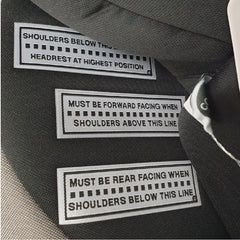Rearward Facing Seats - The Law Vs Best Practice
Posted by Juliet Fernandez on
NOTE: The Australian Standards will soon change to state children are to stay rearward facing till a minimum of 12months old.
There is a lot of confusion as to when the best time is to turn your car seat from rearward facing to forward facing. Let us try to clarify some of the issues by going through the facts.
What are the legal requirements that relate to Rearward Facing Seats?
The Australian national child restraint laws are (NSW Transport for NSW, Centre for Road Safety):
- Children up to the age of six months must be secured in an approved rearward facing restraint
- Children aged from six months old but under four years old must be secured in either a rear or forward facing approved child restraint with an inbuilt harness
However, Kidsafe NSW says:
“Infants are safest if they remain in their rear facing restraint as long as they still fit in their rear facing restraint. While the law allows children over 6 months to use either a rear facing restraint or a forward facing restraint, the rear facing restraint offers better protection as long as the child fits in it.”
This is best practice – Why?
Research done with Neura has shown that rear facing restraints fully support the child’s head and neck when used correctly, thus reducing the risk of injury in an accident especially in a frontal crash. Infant’s heads are relatively large (which is why they are SO cute) and have necks that are not fully developed. This means that, if their heads are not supported, they have a higher risk of serious injury.
Most new car seats are designed for extended rear facing use which will allow children up to 2 – 3 years old to remain in a rear facing position. These seats are call ‘Type A4 restraints’. Type A4/B restraints also allow for extended rear facing but will convert to a forward facing seat when your child is ready.
How do you know if your child still “fits in their rear facing restraint”?
Most seats now have line markers on the inside of the car seat restraint. These markers indicate the shoulder height that a child should reach for the relevant car restraint configuration. So even though the legal requirement is that they must stay in a rearward facing position till 6 months, the Type A4/B seats are designed so that an infant stays in a rearward facing position until they at least reach the first marker - which for most babies is not until 12 months.
At Baby Things, we assess the size and age of a baby when advising parents when the best time to move a child to forward- facing.

"But my baby’s legs seem squashed pushed up against the back of the vehicle seat", I hear you say.
When in the rearward facing position infants will sit with their legs bent and as they get bigger will eventually cross their legs comfortably. The likelihood of fractured legs when the car restraint is in the rearward facing position in an accident is very low. On the other hand, in a forward facing seat, in an accident the child’s legs are thrown forward, striking the vehicle seat in front of it. Some research has shown that broken legs are the second most common injury in a forward facing seat in crashes.
At Baby Things, we strive for best practice so we encourage parents to stay rearward facing till the top of their babies shoulders reach the middle marker as shown in the picture above. This will mean that you baby is in the rearward facing position for as long as the seat allows, as recommended by Kidsafe NSW.
